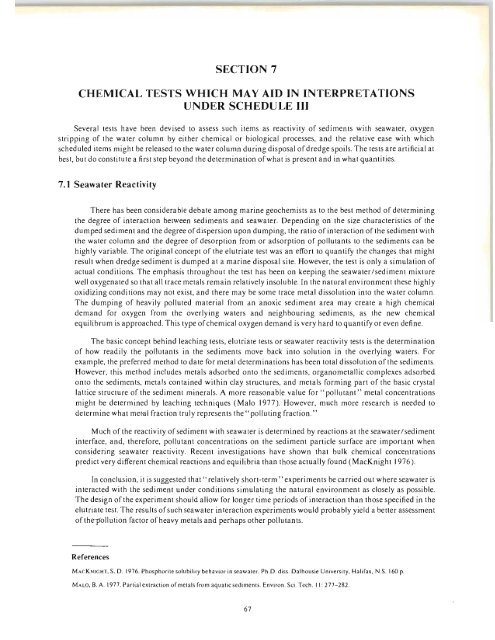Create successful ePaper yourself
Turn your PDF publications into a flip-book with our unique Google optimized e-Paper software.
SECTION 7<br />
CHEMICAL TESTS WHICH MAY AID IN INTERPRETATIONS<br />
UNDER SCHEDULE III<br />
Several tests have been devised to assess such items as reactivity of sediments with seawater, oxygen<br />
stripping of the water column by either chemical or biological processes, and the relative ease with which<br />
sched uled items might be released to the water column during disposal of dredge spoils. The tests are artificial at<br />
best, but do constitute a first step beyond the determination of what is present and in what quantities.<br />
7.1 Seawater Reactivity<br />
There has been considerable debate among marine geochemists as to the best method of determining<br />
the degree of interaction between sediments and seawater. Depending on the size characteristics of the<br />
dumped sediment and the degree of dispersion upon dumping, the ratio of interaction of the sediment with<br />
the water column and the degree of desorption from or adsorption of pollutants to the sediments can be<br />
highly variable. The original concept of the elutriate test was an effort to quantify the changes that might<br />
result when dredge sediment is dumped at a marine disposal site. However, the test is only a simulation of<br />
actual conditions. The emphasis throughout the test has been on keeping the seawater/sediment mixture<br />
well oxygenated so that all trace meta ls remain relatively insoluble. In the natura l environment these highly<br />
oxidizing conditions may not exist, and there may be some trace metal dissolution into the water column.<br />
The dumping of heavily polluted material from an anoxic sediment area may create a high chemical<br />
demand for oxygen from the overlying waters and neighbouring sediments, as the new chemical<br />
equilibrum is approached. This type of chemical oxygen demand is very hard to quantify or even define.<br />
The basic concept behind leaching tests, elutriate tests or seawater reactivity tests is the determination<br />
of how readily the pollutants in the sediments move back into solution in the overlying waters. For<br />
example, the preferred method to date for metal determinations has been total dissolution of the sediments.<br />
However, this method includes metals adsorbed onto the sediments, organometallic complexes adsorbed<br />
onto the sediments, metals contained within day structures, and metals forming part of the basic crystal<br />
lattice structure of the sediment minerals. A more reasonable value for" pollutant" metal concentrations<br />
might be determined by leaching techniques (Malo 1977). However, much more research is needed to<br />
determine what met-a l fraction truly represents the" poIlu ting fraction."<br />
Much of the reactivity of sediment with seawater is determined by reactions at the seawater/sediment<br />
interface, and, therefore, pollutant concentrations on the sediment particle surface are important when<br />
considering seawater reactivity. Recent investigations have shown that bulk chemical concentrations<br />
predict very different chemical reactions and equilibria than those actually found (MacKnight 1976).<br />
In conclusion, it is suggested that" relatively short-term" experimen ts be carried out where seawater is<br />
interacted with the sediment under conditions simulating the natural environment as closely as possible.<br />
The design of the experiment should allow for longer time periods of interaction than those specified in the<br />
elutriate test. The results of such seawater interaction experiments would probably yield a better assessment<br />
of the-pollution factor of heavy metals and perhaps other pollutants.<br />
References<br />
MACKNIGHT, S. D . 1976. Phosphorite solubility behavior in seawater. Ph.D. diss. Dalhousie University, Halifax, N.S. t 60 p.<br />
MALO, B. A. 1977. Partial extraction of metals from aquatic sediments. Environ. Sci. Tech. It: 277 - 282.<br />
67

















